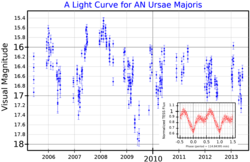AN Ursae Majoris
 A light curve for AN Ursae Majoris. The main plot (from Catalina Sky Survey data[1]) shows the long term variation, and the inset plot (from TESS data[2]) shows the variation over the orbital period. | ||
| Observation data J2000.0
| ||
|---|---|---|
| Constellation | Ursa Major | |
| Right ascension | 11h 04m 25.65570s[3] | |
| Declination | +45 03 13.9415°[3] | |
| Apparent magnitude (V) | 14.9 – 20.2[4] | |
| Characteristics | ||
| Spectral type | pec(e+cont)[4] | |
| Variable type | ||
Semi-amplitude (K1)(primary) | 321 km/s | |
| Details | ||
| White dwarf | ||
| Mass | 0.4–0.6[6] M☉ | |
| Temperature | ≈ 20,000[6] K | |
| Other designations | ||
| Database references | ||
| SIMBAD | data | |
AN Ursae Majoris is a
light years away from the Sun.[3]
This is a single-lined
MG.[6]
References
- ^ "The Catalina Surveys Data Release 2". Catalina Sky Survey. Caltech. Retrieved 19 April 2022.
- ^ "MAST: Barbara A. Mikulski Archive for Space Telescopes". Space Telescope Science Institute. Retrieved 8 December 2021.
- ^ .
- ^ S2CID 125853869.
- ^ doi:10.1086/158301.
- ^ .
- ^ "AN UMa". SIMBAD. Centre de données astronomiques de Strasbourg. Retrieved 2019-08-10.
- hdl:10995/27061.
- doi:10.1086/182506.
